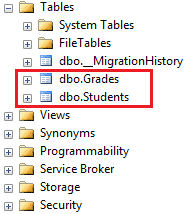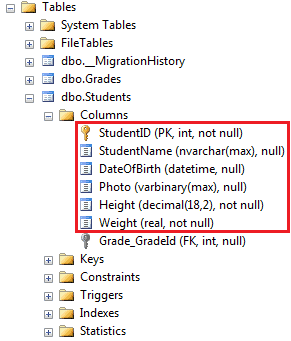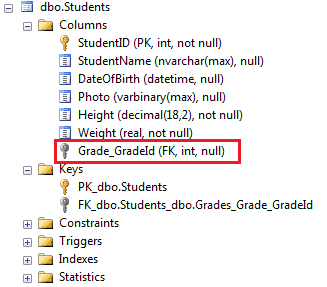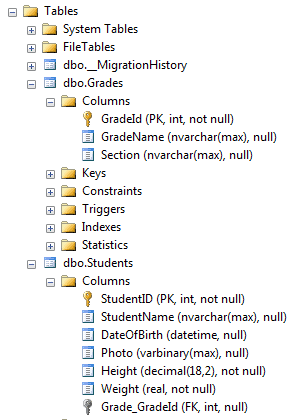An entity in Entity Framework is a class that maps to a database table. This class must be included as a DbSet<TEntity> type property in the DbContext class. EF API maps each entity to a table and each property of an entity to a column in the database.
For example, the following
Student, and Grade are domain classes in the school application.public class Student { public int StudentID { get; set; } public string StudentName { get; set; } public DateTime? DateOfBirth { get; set; } public byte[] Photo { get; set; } public decimal Height { get; set; } public float Weight { get; set; } public Grade Grade { get; set; } } public class Grade { public int GradeId { get; set; } public string GradeName { get; set; } public string Section { get; set; } public ICollection<Student> Students { get; set; } }
The above classes become entities when they are included as
DbSet<TEntity> properties in a context class (the class which derives from DbContext), as shown below.public class SchoolContext : DbContext { public SchoolContext() { } public DbSet<Student> Students { get; set; } public DbSet<Grade> Grades { get; set; } }
In the above context class,
Students, and Grades properties of type DbSet<TEntity> are called entity sets. The Student, and Grade are entities. EF API will create the Students and Grades tables in the database, as shown below.
An Entity can include two types of properties: Scalar Properties and Navigation Properties.
Scalar Property
The primitive type properties are called scalar properties. Each scalar property maps to a column in the database table which stores an actual data. For example,
StudentID, StudentName, DateOfBirth, Photo, Height, Weight are the scalar properties in the Student entity class.public class Student { // scalar properties public int StudentID { get; set; } public string StudentName { get; set; } public DateTime? DateOfBirth { get; set; } public byte[] Photo { get; set; } public decimal Height { get; set; } public float Weight { get; set; } //reference navigation properties public Grade Grade { get; set; } }
EF API will create a column in the database table for each scalar property, as shown below.

Navigation Property
The navigation property represents a relationship to another entity.
There are two types of navigation properties: Reference Navigation and Collection Navigation
Reference Navigation Property
If an entity includes a property of another entity type, it is called a Reference Navigation Property. It points to a single entity and represents multiplicity of one (1) in the entity relationships.
EF API does will create a ForeignKey column in the table for the navigation properties that points to a PrimaryKey of another table in the database. For example,
Grade are reference navigation properties in the following Student entity class.public class Student { // scalar properties public int StudentID { get; set; } public string StudentName { get; set; } public DateTime? DateOfBirth { get; set; } public byte[] Photo { get; set; } public decimal Height { get; set; } public float Weight { get; set; } //reference navigation property public Grade Grade { get; set; } }
In the database, EF API will create a ForeignKey
Grade_GradeId in the Students table, as shown below.
Collection Navigation Property
If an entity includes a property of generic collection of an entity type, it is called a collection navigation property. It represents multiplicity of many (*).
EF API does not create any column for the collection navigation property in the related table of an entity, but it creates a column in the table of an entity of generic collection. For example, the following
Grade entity contains a generic collection navigation property ICollection<Student>. Here, the Student entity is specified as generic type, so EF API will create a column Grade_GradeId in the Students table in the database.
Learn more about how the navigation properties plays an important role in defining entity relationships.




.png)

0 comments:
Post a Comment
Note: only a member of this blog may post a comment.